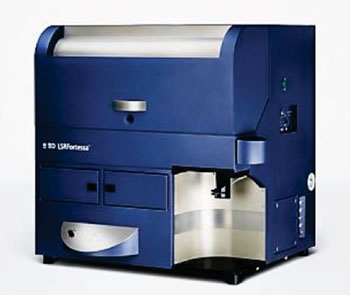Cell Marker Enables Pathogenic Infection Prognosis
By LabMedica International staff writers
Posted on 15 Oct 2015
When a pathogen invades the body, specific cells in the human immune system are ready to take immediate action in order to destroy it, but the molecular characteristics of these killer cells were unknown until recently. Posted on 15 Oct 2015
In some patients, viral infections such as Hepatitis B (HBV) can become chronic as a certain amount of the virus remains permanently in the body, however the immune system cannot control the infection and the disease is not completely cured.

Image: The BD LSR Fortessa Flow Cytometer (Photo courtesy of BD Biosciences).
A large team of scientists led by those at Technical University of Munich (Germany) obtained peripheral blood mononuclear cells (PBMCs) from patients chronically infected with HBV, hepatitis C (HCV), and healthy donors visiting an outpatient clinic. The team used a variety of techniques to create a molecular profile of the protective cells. By studying these immune cells from patients' blood, they were able to predict the course of infections.
Flow cytometric analyses and assessment of mean fluorescence intensity were conducted with a LSR Fortessa (BD Biosciences; San Jose, CA, USA). Total ribonucleic acid (RNA) was extracted with QIAzol Lysis Reagent (Qiagen; Hilden, Germany) and then purified using the Qiagen miRNeasy Mini Kit. The RNA integrity (RNA Integrity Score equal to or greater than 6.8) and quantity were determined on the 2100 Bioanalyzer (Agilent Technologies; Santa Clara, CA, USA). Peptides were separated on an EASY-nLC 1000 HPLC system (Thermo Fisher Scientific; Waltham, MA, USA) coupled online to the Thermo Fisher Scientific Q Exactive mass spectrometer via a nanoelectrospray source.
The investigators found that the fractalkine-receptor/CX3CR1 distinguishes memory CD8+ T cells with cytotoxic effector function from those with proliferative capacity, independent of tissue-homing properties. CX3CR1-based transcriptome and proteome-profiling defined a core signature of memory CD8+ T cells with effector function. They found CD62LhiCX3CR1+ memory T cells that reside within lymph nodes. This population showed distinct migration patterns and positioning in proximity to pathogen entry sites. Virus-specific CX3CR1+ memory CD8+ T cells were scarce during chronic infection in humans but increased when infection was controlled spontaneously or by therapeutic intervention.
Percy A. Knolle, MD, a professor and lead author of the study, said, “Assessing a patient's ability to control an infection has always been a protracted process, because there were no markers to reliably label killer cells, the real 'task force' of the immune system, yet this type of prediction is extremely important for selecting a suitable course of treatment. The new marker will make predictions about the course of infections much faster and more precise. All we need to do is take blood from the patient and identify the number of killer cells using the new marker.” The study was published on September 25, 2015, in the journal Nature Communications.
Related Links:
Technical University of Munich
BD Biosciences
Qiagen




 assay.jpg)








